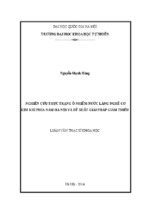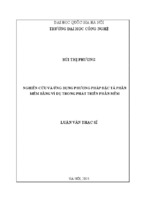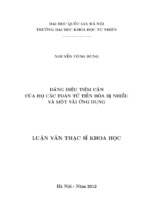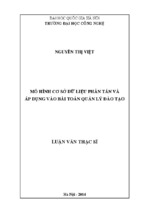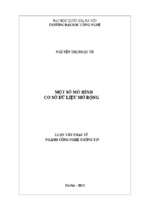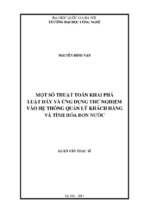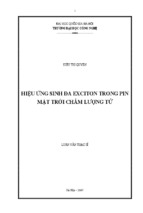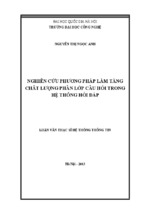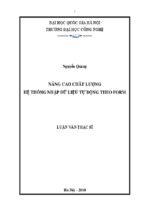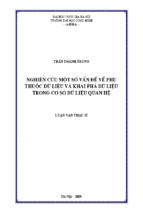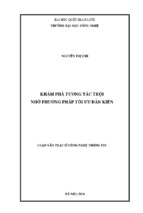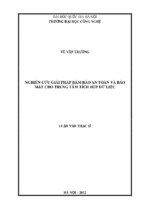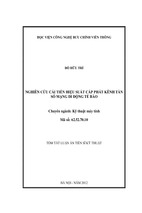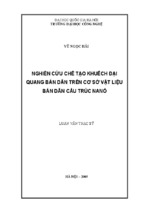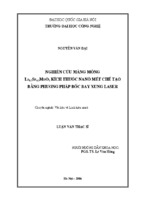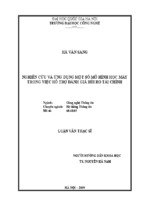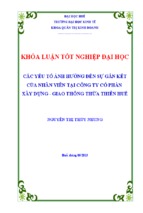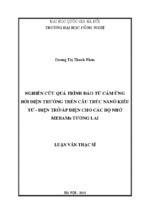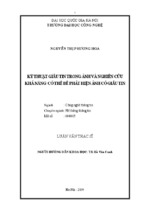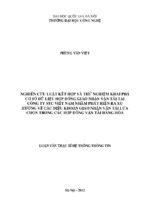DRESDEN UNIVERSITY OF TECHNOLOGY
VNU UNIVERSITY OF SCIENCE
Ngo Van Anh
ASSESSMENT OF CADMIUM FLOWS RELATED TO DOMESTIC
ACTIVITIES AND PROPOSAL OF RECOVERY SOLUTIONS
MASTER THESIS
Hanoi - 2011
DRESDEN UNIVERSITY OF TECHNOLOGY
VNU UNIVERSITY OF SCIENCE
Ngo Van Anh
ASSESSMENT OF CADMIUM FLOWS RELATED TO DOMESTIC
ACTIVITIES AND PROPOSAL OF RECOVERY SOLUTIONS
Major: Waste Management and Contaminated Site Treatment
MASTER THESIS
SUPERVISOR: ASSOC. PROF. DR. NGUYEN THI HA
Hanoi - 2011
ABSTRACTS
This thesis analyses the flows of cadmium (Cd) concerning with domestic
activities in 3 communes (Co Loa, Tho Xuan and Duong Lieu), especially at Co
Loa using MFA (Material flow analysis) or SFA (substance flow analysis) as a
framework. MFA/SFA allows all material/substance inflows, outflows, and stocks
through each sub-compartment in 3 communes to be examined.
The results of the thesis were visualized and presented in diagrams, including
an aggregate diagram. Existing data from a large variety of sources was utilised to
complete all cadmium flows within each commune. Cadmium sources are linked to
activities of households, markets, agricultural production and on-site sanitation
system. A large content of cadmium found in daily domestic solid waste. Phosphate
fertilizers and animal manure have been identified as other significant inputs to
agricultural soils. Based on the findings, appropriate solutions for cadmium
recovery were suggested.
1
ACKNOWLEDGEMENT
My profound gratitude of course reserves for my parents and my relatives
who always create good conditions for me to pursue my education. Their
expectation and support have sustained me during the whole period of my study.
I am most indebted to my supervisor Assoc. Prof. Dr. Nguyen Thi Ha. Thank
you for your patience and for providing consistent direction, encouragement, and
constructive guidance for my thesis.
I also would like to thank Prof. Bernd Bilitewski, Prof. Peter Werner, Assoc.
Prof. Dr. Bui Duy Cam, and Assoc. Prof. Dr. Nguyen Thi Diem Trang for their
significant role in organization and support this course.
Finally, I would like to express my sincere gratitude to my friends who spent
their time helping me do my thesis.
2
TABLE OF CONTENT
ABSTRACTS .............................................................................................................1
ACKNOWLEDGEMENT ........................................................................................2
TABLE OF CONTENT ............................................................................................3
LIST OF TABLES ....................................................................................................5
LIST OF FIGURES ..................................................................................................7
ABBREVIATIONS ...................................................................................................8
INTRODUCTION ....................................................................................................9
CHAPTER 1 – LITERATURE REVIEW ............................................................11
1.1. Overview of cadmium usage and environmental concerns ......................11
1.1.1. Sources and emissions ............................................................................11
1.1.2. Fate, transport and transformation of cadmium in environment.............16
1.1.3. Effect of cadmium on human health and environment ...........................18
1.2. Overview of MFA .........................................................................................21
1.2.1. Terminology used in MFA .....................................................................22
1.2.2. MFA procedure .......................................................................................24
1.2.3. Application of MFA ................................................................................25
1.2.4. Some MFA case studies ..........................................................................27
CHAPTER 2 – APPROACH AND METHODOLOGY......................................38
2.1. Description of study area and scope ...........................................................38
2.1.1. Co Loa commune ....................................................................................38
2.1.2. Tho Xuan commune ................................................................................40
2.1.3. Duong Lieu commune .............................................................................41
2.2. Methodology .................................................................................................42
2.2.1. System analysis .......................................................................................43
2.2.2. Data collection ........................................................................................43
3
2.2.3. Modelling approach ................................................................................44
CHAPTER 3 - RESULTS.......................................................................................46
3.1. Result of cadmium flows identification (qualitative analysis) .................46
3.1.1. Co Loa commune ....................................................................................46
3.1.2. Tho Xuan commune ................................................................................49
3.1.3. Duong Lieu commune .............................................................................53
3.2. Result of Cd flows calculation (quantitative analysis) ..............................57
3.2.1. Cd flows calculation concerning with the activities in households ........57
3.2.2. Cd flows calculation concerning with the activities in markets .............61
3.2.3. Cd flows calculation concerning with industry ......................................64
3.2.4. Cd flows calculation concerning with farmland .....................................65
3.2.5. Cd flows calculation concerning with livestock .....................................68
3.2.6. Cd flows calculation concerning with aquaculture .................................70
3.2.7. Cd flows calculation concerning with S&D ...........................................72
3.2.8. Cd flows calculation concerning with on-site sanitation ........................75
3.2.9. Cd flows calculation concerning with biogas .........................................79
3.2.10. Cd flows calculation concerning with intermediate waste storage .......80
3.2.11. Quantitative diagram .............................................................................81
3.3. Proposal of Cd recovery solutions ..............................................................82
3.3.1. Solutions to recover Cd in solid waste ....................................................82
3.3.2. Solutions to recover Cd in liquid waste ................................................85
CONCLUSIONS .....................................................................................................88
REFERENCES ........................................................................................................90
ANNEXES ................................................................................................................95
4
LIST OF TABLES
Table 1. Range in BRCs of Cd for fine-grained marine sediments, seawater and blue
mussel within the OSPAR area .............................................................................. 12
Table 2. Cadmium and its compounds emissions to air, land and water ................ 15
Table 3. Main physico-chemical properties and registration numbers of Cd .......... 16
Table 4. Cadmium intake for members of the public (1994) .................................. 19
Table 5. Amount of phosphate ore was mined in some countries during 2005 ...... 32
Table 6. Cultivation productivity in Co Loa in 2009 .............................................. 39
Table 7. Breeding productivity in Co Loa in 2009 ................................................. 39
Table 8. Cadmium flows from domestic activities in Co Loa commune ............... 46
Table 9. Cadmium flows from domestic activities in Tho Xuan commune ........... 50
Table 10. Cadmium flows from domestic activities in Duong Lieu commune ...... 54
Table 11. Variables in HH activity .......................................................................... 57
Table 12. Values for calculation of Cd flows in HH activity ................................. 59
Table 13. Summary for Cd flows calculation concerning with activities in HH .... 61
Table 14. Variables in markets activity ................................................................... 62
Table 15. Values for calculation of Cd in markets activity .................................... 62
Table 16. Summary for Cd flows calculation concerning with activities in markets 63
Table 17. Variables in industry activity ................................................................... 64
Table 18. Values for calculation of Cd flows in industry activity .......................... 64
Table 19. Summary for Cd flows calculation concerning with industry ................. 65
Table 20. Variables in farmland activity ................................................................. 66
Table 21. Values for calculation of Cd flows in farmland activity ......................... 66
5
Table 22. Summary for Cd flows calculation concerning with farmland ................ 67
Table 23. Variable in livestock activity .................................................................. 68
Table 24. Values for calculation of Cd flows in livestock activity ......................... 69
Table 25. Summary for Cd flows calculation concerning with livestock ................ 70
Table 26. Variables in aquaculture activity ............................................................ 71
Table 27. Values for calculation of Cd flows in aquaculture activity .................... 71
Table 28. Summary for Cd flows calculation concerning with aquaculture ........... 71
Table 29. Variables in S&D activity ....................................................................... 72
Table 30. Values for calculation of Cd flows in S&D ............................................ 73
Table 31. Summary for Cd flows calculation concerning with S&D ..................... 75
Table 32. Variables in septic tank system ............................................................... 76
Table 33. Values for calculation of Cd flows in septic tank system ....................... 76
Table 34. Variables in double vaults toilet system .................................................. 77
Table 35. Values for calculation of Cd flows in double vaults toilet system ......... 77
Table 36. Variables in on-site sanitation activity ..................................................... 78
Table 37. Summary for Cd flows calculation concerning with on-site sanitation ... 78
Table 38. Variables in biogas activity ...................................................................... 79
Table 39. Values for calculation of Cd flows in biogas activity .............................. 79
Table 40. Summary for Cd flows calculation concerning with biogas .................... 80
Table 41. Variables in intermediate waste storage activity ..................................... 80
Table 42. Values for calculation of Cd flows in intermediate waste storage activity 80
Table 43. Summary for Cd flows calculation concerning with intermediate waste
storage ..................................................................................................................... 81
6
LIST OF FIGURES
Fig. 1. Graphical representation of an MFA system ............................................... 24
Fig. 2. MFA procedure ............................................................................................ 25
Fig. 3. Co Loa commune ......................................................................................... 38
Fig. 4. Tho Xuan commune ..................................................................................... 40
Fig. 5. Duong Lieu commune ................................................................................. 41
Fig. 6. Protocol for substance flow analysis ........................................................... 42
Fig. 7. System analysis of domestic activities in Co Loa ....................................... 49
Fig. 8. System analysis of domestic activities in Tho Xuan ................................... 53
Fig. 9. System analysis of domestic activities in Duong Lieu ................................ 56
Fig. 10. Input and output flows concerning with household activity...................... 57
Fig. 11. Input and output flows concerning with markets activity .......................... 61
Fig. 12. Input and output flows concerning with industry activity .......................... 64
Fig. 13. Input and output flows concerning with farmland activity ........................ 65
Fig. 14. Input and output flows concerning with livestock activity ........................ 68
Fig. 15. Input and output flows concerning with aquaculture activity ................... 70
Fig. 16. Input and output flows concerning with S&D activity .............................. 72
Fig. 17. Input and output flows concerning with on-site sanitation activity ........... 75
Fig. 18. Input and output flows concerning with septic tank system ...................... 76
Fig. 19. Input and output flows concerning with double vaults toilet system ........ 77
Fig. 20. Input and output flows concerning with biogas activity............................. 79
Fig. 21. Input and output flows concerning with intermediate waste storage activity80
Fig. 22. Quantitative diagram for Cd flows in Co Loa commune .......................... 82
7
ABBREVIATIONS
ELM
Emulsion liquid membranes
EW
Electro winning
FAO
Food and Agriculture Organization
GESAMP
Joint Group of Experts on the Scientific Aspects of
marine Pollution
GW
Groundwater
HH
Households
IARC
International Agency for Research on Cancer
kt
Kilotons
MFA
Material flow analysis
OECD
Organization for Economic Co-operation and
Development
PVC
Polyvinyl chloride
SFA
Substance flow analysis
S&D
Sewer and drainage system
SX
Solvent extraction
The OSPAR Convention
The Convention for the Protection of the Marine
Environment of the North-East Atlantic
US EPA
United State Environmental Protection Agency
WC
Water closet
WHO
World Health Organization
8
INTRODUCTION
Cadmium is usually found in trace amounts as a component of the surface
soil, sediments and surface water, and in the air. However, most of the cadmium in
the environment results directly from human activities. Cadmium is not essential to
living organisms. It enters the human body via food, smoking, and inhalation of
contaminated air. It is extremely dangerous as it is easily absorbed and remains in
the tissues for a long time. Because of the slow rate of cadmium excretion, levels in
the body increase with age in situations of chronic exposure. Human kidney disease
(renal dysfunction) is one result of such long-term exposure (WHO 1992).
Assessment of cadmium flows by material flow analysis method originally
developed by Baccini and Brunner, 1991; can provide a holistic picture of resource
use and loss in a geographic region in a specific year. In industrialized countries,
MFA proved to be a suitable instrument for the early recognition of environmental
problems and development of countermeasure. It can be applied to analyze resource
flows in a city, particularly to evaluate the impact of changes in consumption
patterns, solid waste and wastewater treatment infrastructure, peri-urban agricultural
production, including waste and wastewater reuse practices on resource
consumption and environmental pollution. It also provides useful information for
planners and decision-makers and could help improve resource management of
areas in developing countries. However, limited data availability, reliability and
data collection means (available laboratory equipment, trained laboratory staff,
financial and human resources) are common problems faced by developing
countries and restrain the use of MFA as a policy-making tool.
The aim of this study is to apply MFA to analyze the cadmium flows through
domestic activities to the environment. The study areas are 3 communes (Co Loa –
peri-urban area, Tho Xuan – rural area and Duong Lieu - craft village area. Contents
of thesis include:
9
9 Description and understanding the activities related to cadmium flows
9 Qualification and quantification these flows
9 Recommendation of appropriate solutions for cadmium recovery
10
CHAPTER 1 – LITERATURE REVIEW
1.1. Overview of cadmium usage and environmental concerns
1.1.1. Sources and emissions
Cadmium is released to the biosphere from both natural and anthropogenic
sources.
1.1.1.1. Natural sources
Many substances, such as cadmium, occur naturally in the environment and
it is therefore important to distinguish between natural concentrations and flows of
these substances and the extent to which these are increased by human activities.
Volcanic activity is an important natural source of the release of cadmium to
the atmosphere. The annual global flux from this source has been estimated to be
820 tons (Nriagu, 1989). Deep-sea volcanism is also a source of the release of
cadmium to the environment, but the role of this process in the global cadmium
cycle still remains to be quantified. Levels of up to 4.5 mg/kg have been found in
volcanic soils (Korte, 1983).
Cadmium present in various types of rocks and soils is widely distributed in
the earth's crust, in non-volcanic areas, at average concentrations ranging from 0.1
to 0.2 mg/kg of soil (GESAMP, 1984). This metal is commonly associated to zinc,
and occurs naturally in zinc, lead and copper ores, which are the main deposits of
cadmium. These deposits can reach ground and surface waters, especially when in
contact with soft, acidic waters.
For
naturally
occurring
substances
the
Background/Reference
Concentrations (BRCs) are the range of concentrations that would be anticipated to
be present in the environment in the absence of any human activity. Obviously,
nowadays it is virtually impossible to present a definitive value for the background
concentration of natural stable compounds, which can be transported by wind, water
and biota.
11
Table 1 summarizes available BRCs for cadmium in seawater, sediments and
biota (mussel tissue)
Table 1. Range in BRCs of Cd for fine-grained marine sediments, seawater
and blue mussel within the OSPAR area (2002) a
a
: from OSPAR Commission, 2002
1.1.1.2. Anthropogenic sources
There are a number of sources of anthropogenic cadmium emissions into the
environment. Many of these are emitted as a result of activities not (directly)
associated with the production and use of cadmium-containing products. These
include (Nordic Council of Ministers, 2003):
• Refining of non-ferrous metals - residual levels of cadmium in zinc and lead
ores; copper refining with the level of emissions is low.
• Production of iron and steel - emissions to air, water and landfill may result
from several of the input materials and processes for converting iron ore,
12
coke and limestone/fluorspar to iron; production of refined steel from pig
steel; or for secondary production of steel from scrap steel.
• Combustion of fossil fuels - cadmium is a natural component of fossil fuels.
Electric power plants burning fossil fuels (coal and/or oil) release cadmium
contained in the fuels which contain zinc sulphides. As much as 190 ppm of
cadmium occurs in mid-continental coals in the US. Most cadmium will be
captured in the fly ash and emission control devices; a small volume may be
present in the slag/bottom ash which is landfilled or immobilized in cement
or asphalt-type processes.
• Production/use of phosphate fertilizer - cadmium is contained in the
phosphate fertilizers from the original rock phosphate. Emissions may also
occur through losses to water during the manufacturing process and disposal
of by-product gypsum to sea and disposal of gypsum to landfill. Minor
emissions may take place to air through dust created during manufacture.
• Production of cement - cadmium is present as trace element in the raw
materials of cement production. Emissions may result from the feed system,
kiln system, clinker-cooling and handling system. Emissions to air as dust
are likely, while direct emissions to water are not.
Cadmium also enters the environment through the disposal of solid and
liquid wastes, some of which will be associated with the production and use of
cadmium-containing products (United Nations Environment Programme, 2008)
• Application of sewage sludge - to soil through application to land as fertilizer.
• Incineration of domestic waste - cadmium is also released as a result of
incinerating cadmium stabilized PVC and other products containing
cadmium pigments or cadmium compounds found in commercial and
household waste.
13
• Leaching from landfill - cadmium concentration in leachates from controlled,
state-of-the-art industrial or municipal landfills is often below the detection
limit. By way of example, in a case study in Denmark on a landfill
containing industrial/municipal waste, demolition waste, 3% hazardous
waste – no elevated cadmium was observed and the concentration was below
detection.
Table 2 shows the most significant sources of cadmium emissions in some
European countries, taking into account overall use of cadmium
14
Table 2. Cadmium and its compounds emissions to air, land, and water (2009) a
a
: from Urszula Zielonka et al., 2009
15
1.1.2. Fate, transport and transformation of cadmium in environment
1.1.2.1. Fate of cadmium in environment
Cadmium is a natural element in the earth's crust. Pure cadmium is a soft,
silver-white metal; however cadmium is not often found in the environment as a
metal. It is usually found as a mineral combined with other elements such as oxygen
(cadmium oxide), chlorine (cadmium chloride), or sulfur (cadmium sulfate,
cadmium sulfide). These compounds are solids that may dissolve in water but do
not evaporate or disappear from the environment. Physico-chemical properties and
classification numbers of cadmium compounds were summarized in the WS Atkins
Report (see table 3).
Table 3. Main physico-chemical properties of Cd compounds (2000) a
a
: from Caspar Corden et al., 2000
16
1.1.2.2 Transport and transformation of cadmium in environment
Cadmium is released by various natural and anthropogenic sources to the
atmosphere, aquatic environments (fresh and salt water environments) and
terrestrial environments. There are fluxes between these environmental components.
Cadmium released to the atmosphere can deposit to land and aquatic environments,
and some cadmium emitted to soil over time will be washed out to the aquatic
environments. The long-term sinks are deep-sea sediments and, to a certain extent,
controlled landfills, in cases where, owing to its physico-chemical properties,
cadmium is immobilized and remains undisturbed by anthropogenic or natural
activity (climatic and geological).
Cadmium, once released to air, is subject to atmospheric transport. It is
mainly emitted to the atmosphere in particle form. The atmospheric transport of
cadmium is governed by aerosol (particle) transport mechanisms: in the atmosphere,
cadmium may be transported on local, national, regional or intercontinental scales,
depending on various factors, including, for both natural and anthropogenic sources,
particle size, the height of emission outlets and meteorology. Because it has a
relatively short residence time in the atmosphere (days or weeks), however, this
metal is mainly transported over local, national or regional distances.
Based on the relatively scarce specific evidence available, cadmium is
considered to be subject to a certain degree of long-range air transport on an
intercontinental scale. Intercontinental transport is, however, expected to make only
a minor contribution to cadmium levels in regions affected by other, local emitting
sources. The regional and intercontinental atmospheric transport of cadmium
contributes to deposition in remote regions, such as the Arctic, where there are few
local sources for cadmium releases.
There is no hemispheric transport modeling for cadmium. As cadmium
transport is governed by aerosol transport mechanisms similar to those governing
the transport of lead (both are transported on aerosol particles with similar
17
properties), the transport of lead might be used as a rough surrogate of the potential
intercontinental transport of cadmium. Lead modeling is described in the United
Nations Environment Programme review of scientific information on lead. Taking
into account the general similarities between the long-range atmospheric transport
of cadmium and lead and building on observations for lead, major contributions to
Arctic cadmium pollution can be expected, as is the case with lead pollution, to
come from sources located in Europe and in Siberia.
With regard to aquatic systems, rivers transport cadmium and other heavy
metals on a national and regional scale. Ocean transport also occurs. The oceanic
residence time of cadmium has been estimated at about 15,000 years. This indicates
that cadmium may be accumulated and transported in significant amounts over long
distances in the ocean. It should be noted, however, that oceans have large natural
reservoirs of cadmium. The contribution of cadmium via rivers into the marine
environment of the North Sea is in the same order of magnitude as the atmospheric
deposition, which is the other main pathway of cadmium inputs in the region
(United Nations Environment Programme, 2008).
1.1.3. Effect of cadmium on human health and environment
1.1.3.1. Human exposure pathways and effect of cadmium on human health
• Non-Occupational Exposure
Typical figures for cadmium intake by members of the public within the
European Union are summarized in Table 4.
The cadmium intake is dominated by dietary intake and some foodstuffs are
cadmium “rich” - such as shellfish, root vegetables and cereals – leading to certain
population groups being at a higher risk. In areas of contamination, levels of
cadmium may be much higher leading to daily intakes of >100 mg (Järup et al.,
1998). Although cadmium use in stabilizers, pigments and plating will make a
contribution to these figures, other sources may be more significant (United Nations
Environment Programme, 2008).
18
- Xem thêm -


